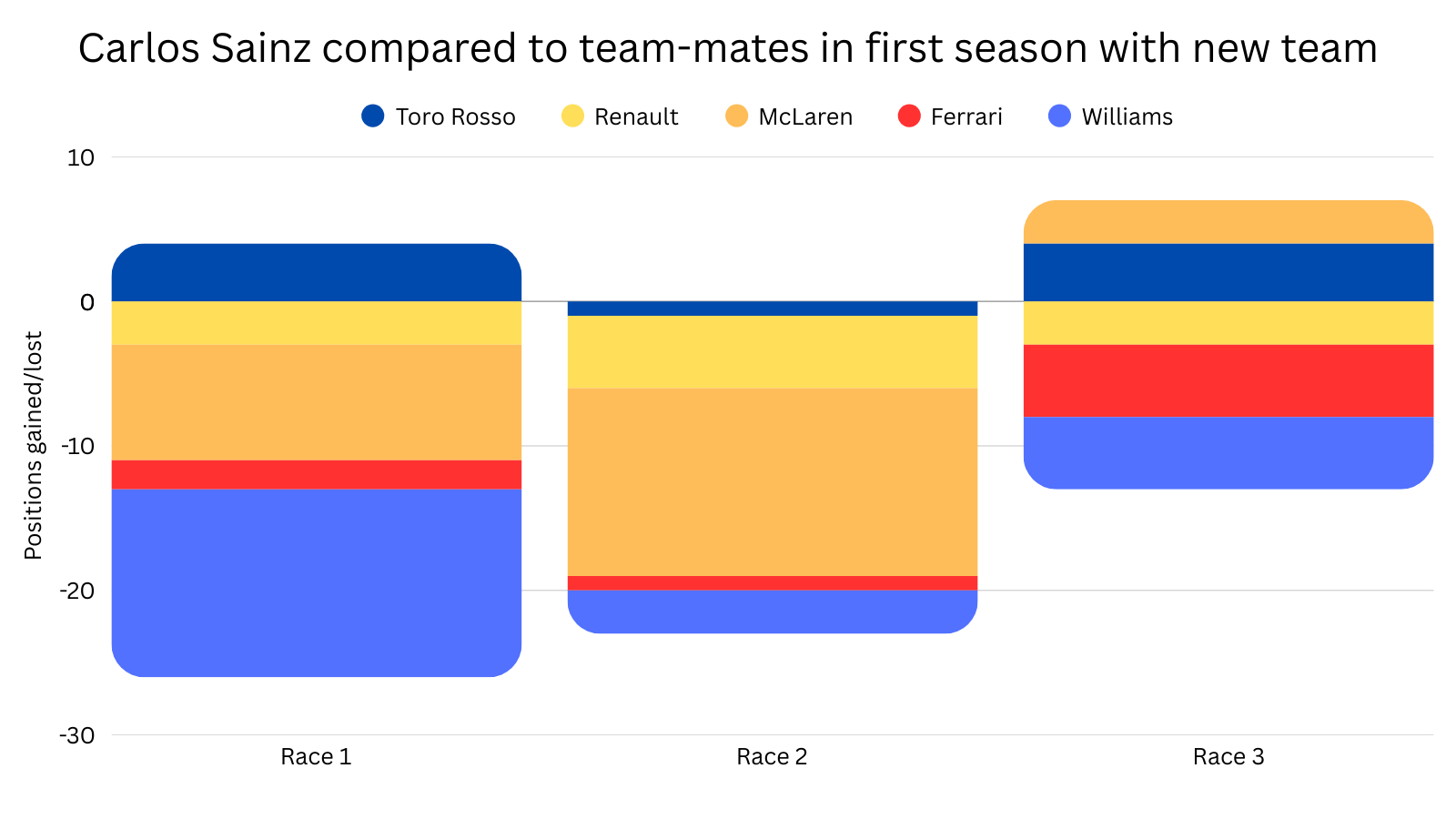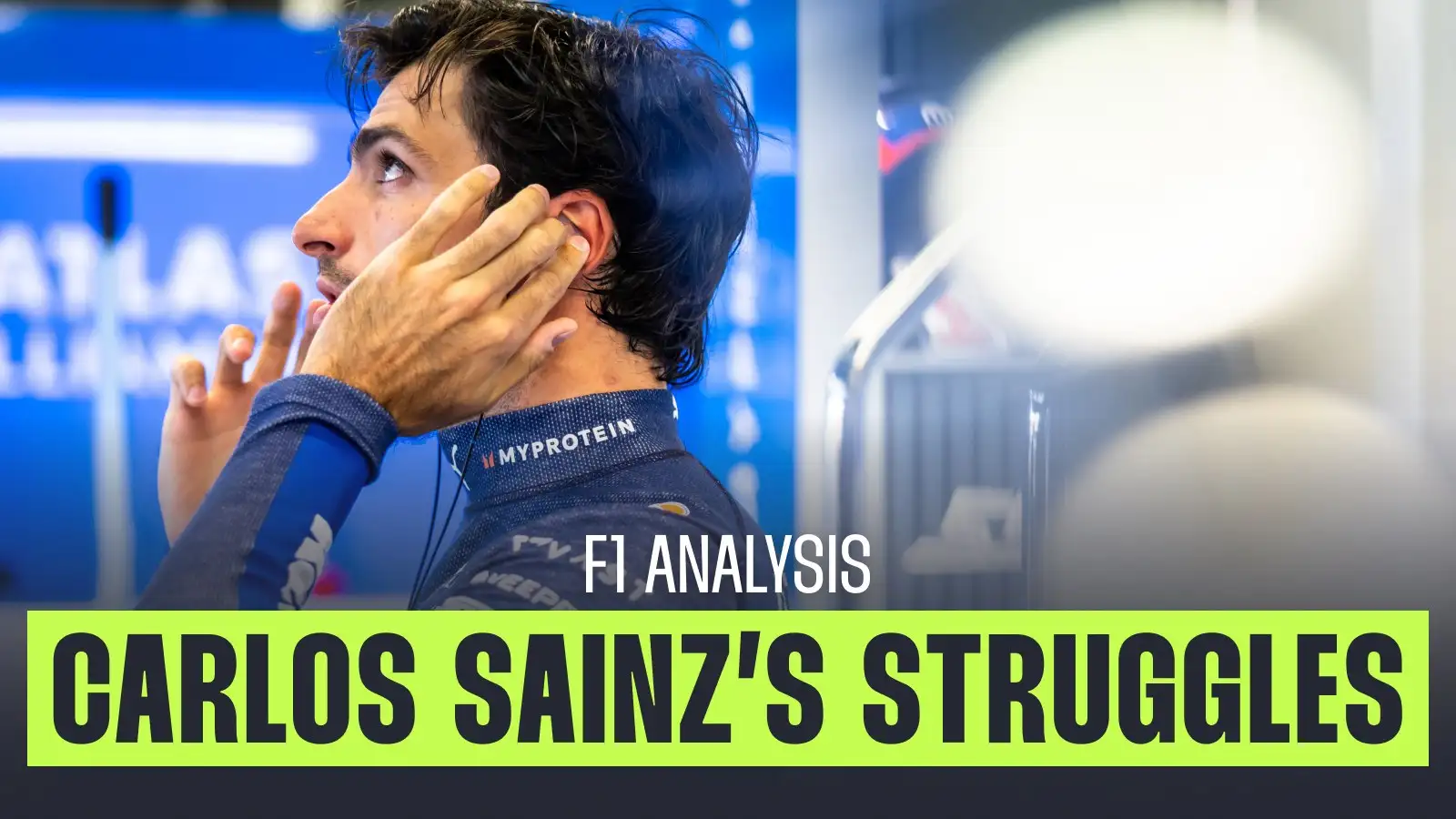Carlos Sainz has found life difficult so far in the seat of the Williams, but is it a poor run of form or something more concerning?
Expected by many to hit the ground running, Sainz has instead scored just one point in three races and is looking at odds with the Williams car.
What Carlos Sainz’s history says about Williams struggles
Carlos Sainz tends to start slowly at new teams
Williams is the fifth team Sainz has driven with in his F1 career, meaning we have plenty of data to look at when it comes to how he starts.
Taking into account the first three races Sainz had with a new team (in Renault’s case, we have used the start of the 2018 season rather than his short stint at the end of 2017) we can see a familiar result forming.

In all but three races, Sainz finished behind his new team-mate, suggesting there is not too much concern to be had this year but the deficit to Albon has been the biggest of his the Spaniard’s career, save McLaren.
But even his time at Woking comes with an asterisk. In his first three races against Lando Norris, Sainz retired with mechanical issues in two of them. In the third race of the year, it was Norris’ turn for a retirement.
If we discount mechanical issues then, Sainz finished ahead of Norris in the first three races.
The same cannot be said of his Williams stint so far as both drivers have crossed the finishing line in every race, making it all the more concerning for Sainz. The Spaniard has so far finished a combined 21 places behind his new team-mate.
How does Carlos Sainz’s deficit compare across the grid?
If we look at the points scored across the season from every team so far, we can see that only three teams have a more lopsided duo.
Red Bull, Aston Martin and Sauber all have one driver scoring 100% of the points while Williams are fourth with 95% coming from Albon, a share that would be even worse had there not been multiple DQs in China.
But with those three teams, there is clear number one of Max Verstappen at Red Bull and Nico Hulkenberg at Sauber. It is only Lance Stroll at Aston Martin that is an outlier.
Historically, Sainz has never scored less than a quarter of the points share, with his lowest being his 27% of 2015 along Max Verstappen but in general, the Spaniard pulls his weight far more.
The best he has done is the 91% of Toro Rosso’s points he got in 2017 while his lowest aside from 2015 is the 43% he got in his first full season at Renault.
Of course, just three races have passed so far but given Albon’s form, Sainz will have to make quite the turnaround to avoid scoring less than half of Williams’ points this year.
Is it Carlos Sainz’s car?
If a driver is struggling, the absolute worst thing for them is if their team-mate is doing well.
Our data expert Pablo Hidalgo crunched the numbers following the Chinese Grand Prix and it highlighted the areas that Sainz was struggling in compared to Albon.
Chiefly amongst them is confidence in the car. In sprint quali for China, Albon was faster through a lot of corners and when Sainz attempted to wrestle back some lap time, he was overly aggressive in Turn 16 and it cost him.
Albon built a gap of 0.786 seconds in SQ2, highlighting the pace difference between the two and how much each driver trusts the car at this stage.
It is not just a quali problem either and Sainz has struggled in races, especially when it comes to tyre preservation. Even in the sprint, his tyres fell off a cliff after lap 10 and it resulted in a P17 finish.
In the China race, at the same time that Sainz’s tyre gave away, Albon set a personal fastest lap. By the end of it, Albon was half a second quicker than Sainz per lap, a worrying statistic for the four-time race winner.
It would seem then that Sainz’s adjustment period is taking longer than many expected but when will he be back in form? The man himself has an answer for that.
When will Carlos Sainz be back on form?
The question of when we should expect to see Sainz comfortable with the car was answered by the driver during the Japanese GP weekend and it may be a while yet.
He said: “First of all, it depends how far away it is from your natural driving style. The further away, the longer that process is.
“I think it also depends what you consider your 100%. If your 100% is to close your eyes and drive and you’re just naturally quick, then that’s probably where the ideal place is.
“Then it takes, let’s say, even more than a year to get to that point.
“If your 100% is just to perform at a very high level in Formula 1, which that’s where I want to get to as soon as possible, that for me, should take less than half a year. Five to 10 races.
“That’s the way I see it, or the way I am expecting [for] myself and targeting myself to be. As soon as I get different kinds of tracks and different kinds of surfaces. With the tarmacs, different levels of grip. Different levels of downforce in the car.
“So it takes time to get to a good level, but at the same time, I enjoy the challenge and it’s like, once you find the click, it always feels good and I’ve always found that click.”
More analysis from PlanetF1.com
Concerning Lewis Hamilton data emerges in rare Hadjar comparison
Japanese GP conclusions: Verstappen’s Alonso-esque rampage, McLaren tactics, the real Doohan mistake
A slow Carlos Sainz start – but it is by no means terminal
Three races in with one point makes it easy for some to cast off Sainz as a failure already but just 12.5% of the season has been run.
History shows that Sainz does not always start on the front foot meaning we, as the man says, should wait until at least 10 races to make any definitive conclusions.
Read next: McLaren’s strategy indecision is the biggest threat to their title chances
